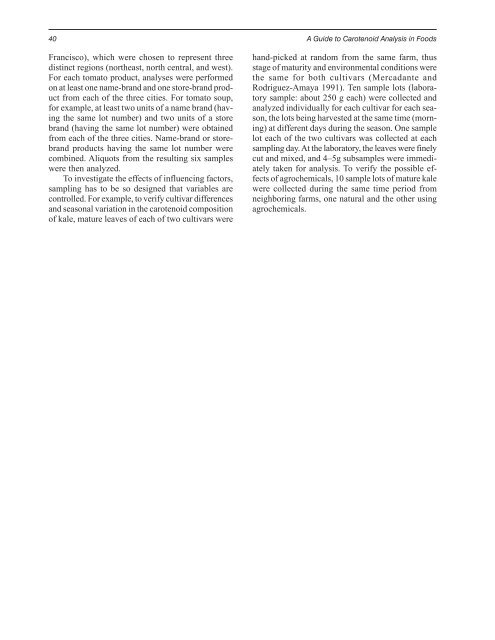A GUIDE TO CAROTENOID ANALYSIS IN FOODS
A GUIDE TO CAROTENOID ANALYSIS IN FOODS
A GUIDE TO CAROTENOID ANALYSIS IN FOODS
Create successful ePaper yourself
Turn your PDF publications into a flip-book with our unique Google optimized e-Paper software.
40 A Guide to Carotenoid Analysis in Foods<br />
Francisco), which were chosen to represent three<br />
distinct regions (northeast, north central, and west).<br />
For each tomato product, analyses were performed<br />
on at least one name-brand and one store-brand product<br />
from each of the three cities. For tomato soup,<br />
for example, at least two units of a name brand (having<br />
the same lot number) and two units of a store<br />
brand (having the same lot number) were obtained<br />
from each of the three cities. Name-brand or storebrand<br />
products having the same lot number were<br />
combined. Aliquots from the resulting six samples<br />
were then analyzed.<br />
To investigate the effects of influencing factors,<br />
sampling has to be so designed that variables are<br />
controlled. For example, to verify cultivar differences<br />
and seasonal variation in the carotenoid composition<br />
of kale, mature leaves of each of two cultivars were<br />
hand-picked at random from the same farm, thus<br />
stage of maturity and environmental conditions were<br />
the same for both cultivars (Mercadante and<br />
Rodriguez-Amaya 1991). Ten sample lots (laboratory<br />
sample: about 250 g each) were collected and<br />
analyzed individually for each cultivar for each season,<br />
the lots being harvested at the same time (morning)<br />
at different days during the season. One sample<br />
lot each of the two cultivars was collected at each<br />
sampling day. At the laboratory, the leaves were finely<br />
cut and mixed, and 4–5g subsamples were immediately<br />
taken for analysis. To verify the possible effects<br />
of agrochemicals, 10 sample lots of mature kale<br />
were collected during the same time period from<br />
neighboring farms, one natural and the other using<br />
agrochemicals.

















